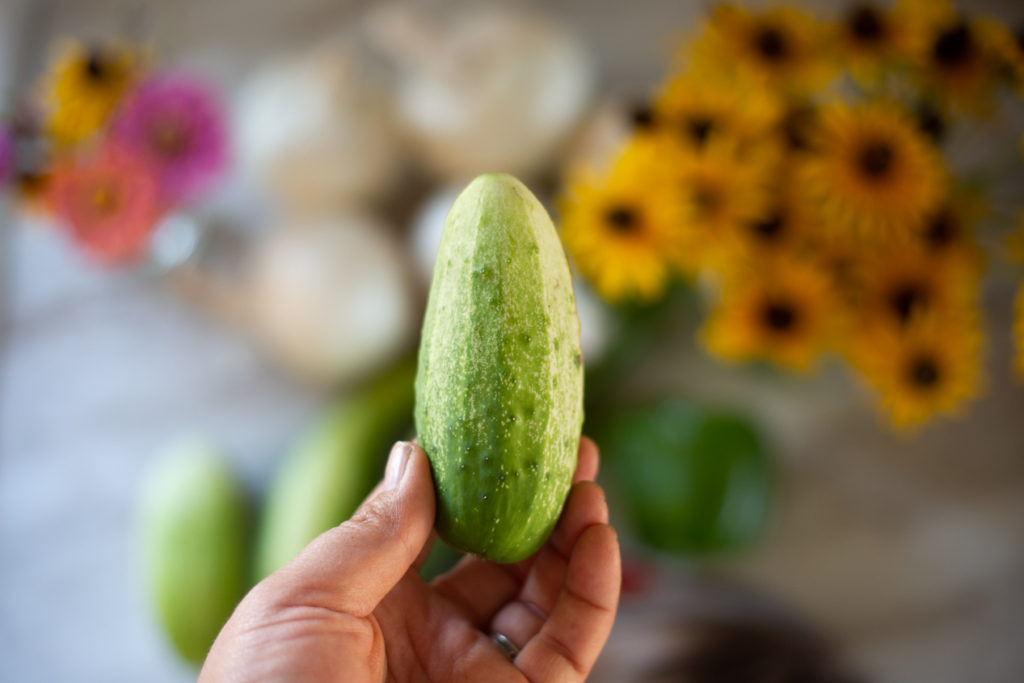Delicious and economical canned foods start with the source. Let me explain where to get produce for canning even without growing your own garden! Soon you’ll be on your way to canning jams, pickles, soups, condiments, and more.

The Best Places to get Produce for Canning
Your Garden
Your own garden can be one of the best, most bountiful sources for produce for canning. Growing fruits and vegetables requires full sun (at least 8 hours of direct, unfiltered light a day). It’s also a good way to make sure your produce is organic, if you choose. If you don’t have the space or adequate sun, rent a community garden plot or garden with a friend at his or her place. Share the work and the bounty!

Farmers Market
Cities of every size throughout the country have farmer’s markets, where local growers sell picked-that-morning produce. Shop on a weekend morning and spend the afternoon canning.

Pick Your Own
My children and I do this every year to source our blueberries! Visit these farms in season to harvest at a reasonable cost. After all, you provide the labor. Strawberries are by far the most popular produce to purchase that these farms because the berries take large amounts of space to grow. Also popular are apples, peaches, blueberries, raspberries, and pumpkins.

Community Supported Agriculture
Over the last 20 years, community-supported agriculture groups (CSAs) have become popular. Typically consumers purchase hares in a local CSA and in return either pick up or receive a delivery for a set amount of seasonal produce each week throughout the growing season. Search online for CSAs in your area, or ask at a farmer’s market, roadside stand, or local food cooperative. Canners should take to a CSA coordinator to find out about availability of larger amounts of certain types of produce for preserving.

Grocery Stores
Supermarkets and local food cooperatives may be sources for produce for preserving too. Granted you’ll pay top dollar and may have to purchase produce in small inconvenient packages…. but grocery stores may be a good source for less expensive bulk items such as onions or apples, or for items that aren’t locally grown, such as oranges.

Know Your Produce for Canning
Not all tomatoes are created equal. Or Cucumbers. Or even grapes. Understand key differences among fruits and vegetables to make sure canning projects turn out perfectly.

Undamaged and Unblemished are best for Canning
When you put top-quality produce in a jar, you get top-quality product coming out of it. Use produce within a day or two of harvesting or purchasing. Store in the refrigerator if necessary (except for tomatoes). Discard produce that is diseased, moldy, or insect-damaged, though you can cut out mall bruises and spots.
Sweetness and Ripeness in Produce Affect Canning
Choose produce that is moderately ripe. Avoid fruit that is overripe or under-ripe (with the exception of recipes that specify, say, green tomatoes). Fully ripe yet firm fruit has the best, fullest flavor and processes the best. In some cases recipes specify the ripeness of the fruit–it’s that critical. Berries and fruits at the peak of their flavor will mash into the correct consistency and produce the most delicious jams and jellies. Under-ripe or inferior berries have less flavor and a less-ideal texture.

Pay attention to Acidity
Some fruits and vegetables have higher acid levels than others. Acidic produce is naturally easier to preserve because the acid inhibits the grown of some microorganisms. This is why so many home canning recipes rely on vinegar and lemon juice–they are both very acidic!
Pectin Levels Count
This natural substance occurs in a variety of fruits. It’s what causes jams and jellies to gel. Most recipes call for the addition of pectin, but some fruits, such as gooseberries, naturally have so much pectin that adding more isn’t necessary. Under-ripe fruit is high in pectin; overly ripe fruit is low in pectin. So, making preserves with overripe fruit might result in a runny product. Because the sugar in each recipe interacts with the pectin, it is best not to alter the amount of sugar.

Variety of of Produce for Canning
Some varieties or cultivators of produce process better for canning than others. Paste-type tomatoes, are firmer and meatier with fewer seeds and juice than a beef-steak or slicing tomato. Pickling cucumbers, are firmer and stand up to the brining process better, remaining crisp and delicious! AVOID WAX ON PRODUCE–it prevents absorption of the liquids. Different grapes have different flavors, juiciness and pectin levels. Use the grape specified in a recipe whenever possible.
There are many ways to get produce for canning with and without your own garden it just takes a little work seeking out those sources that will provide the right produce for your next canning project!

Other Posts You May Enjoy:
How to Get Started Canning for Beginners
Ideas for What to Have on a Homestead | Homestead Planning
How to Enjoy Gardening When It’s Not Your Thing
How to Get Canning Done with Kids
A Freezer is Essential on the Homestead
How to Stay Motivated on the Homestead

Leave a Reply